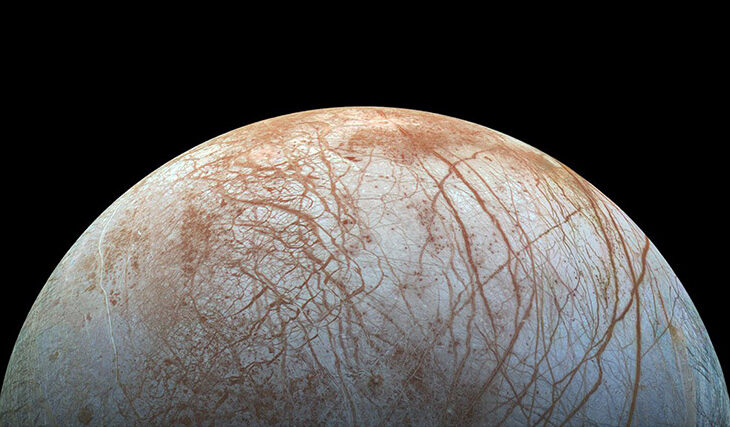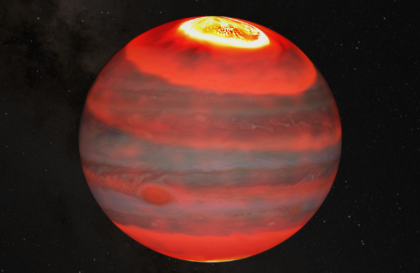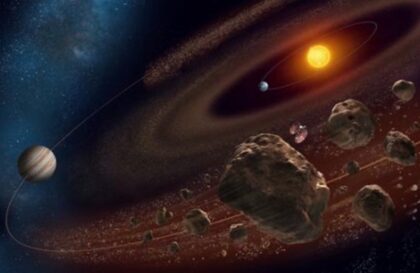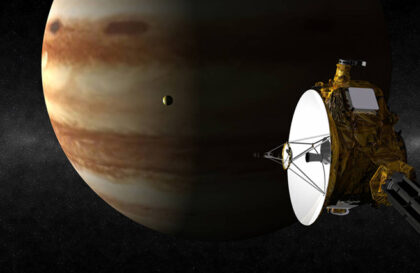Europa holds the palm in the solar system for the smoothness of its surface. There are no mountains, hills, or depressions on it. The difference in altitude between different areas of the satellite is, at most, several hundred meters. But its night side glows under the influence of unbearable radiation.
Europa, also known as Jupiter II, is the smallest of the four Galilean moons orbiting Jupiter, discovered in 1610 by Galileo Galilei. Its unique formation and composition distinguish it from other celestial bodies. The icy moon is mainly composed of silicate rock and has a water-ice crust, leading scientists to speculate that there may be a subsurface ocean beneath its surface. Recent discoveries of carbon sources on Europa’s icy surface further support the subsurface ocean hypothesis, as carbon is a crucial element for life.
One of the most intriguing aspects of Europa is the presence of a subsurface ocean beneath its cracked ice shell. Ice thickness up to 18 miles (30 km). The existence of liquid water under the surface of Europa has been confirmed by previous missions, in particular thanks to observations made by the magnetometer on the Galileo spacecraft. This subterranean ocean is believed to be a vast body of salt water, making it a potential habitat for life.
Europa’s surface features and geology have fascinated both astronomers and scientists. Its icy surface is constantly bombarded by sulfur ions from Jupiter’s moon Io, which are embedded in Jupiter’s magnetosphere. This bombardment contributes to the unique appearance of Europa’s surface, marked by a complex network of cracks and ridges. Some of these surface features are thought to result from tectonic activity caused by tidal forces caused by Jupiter’s immense gravity.
Solar radiation and Jupiter’s magnetic field create radiation on Europa of approximately 5,400 millisieverts. This kills a person in less than 24 hours. Conventional computed tomography gives 6-20 millisieverts.
Europa’s surface may consist of ice and common salts on Earth, such as magnesium sulfate (Epsom salt) and sodium chloride (table salt). The new study shows that incorporating these salts into water ice under conditions similar to those on the satellite and exposing it to radiation results in the glow.
The icy surface can glow under the influence of a relentless stream of radiation on its night side, facing away from the Sun. Variations in the glow and the color of the glow itself can reveal information about the composition of the ice on Europa’s surface. Credit: NASA/JPL-Caltech.
Europa’s surface is younger than the moon itself.
Europa is about the same age as the rest of the solar system. However, its surface is only 40 to 90 million years old. This happened because the satellite’s crust constantly bends under the influence of tides. This process sustains tectonic activity, which, in turn, continually changes the surface. This happens in many ways, similar to Earth, where tectonic activity continuously transforms the Earth’s surface.
In 2018, NASA scientists discovered ice plumes on Europa that gush warm water from the ocean and create water vapor. The height of the plumes reached 125 miles (200 km). In this way, Europa is similar to Saturn’s moon Enceladus.
Europa moves in a circular orbit around Jupiter, a distinctive feature given that the other moons have more eccentric trajectories. This gives Europa a more stable orbit compared to other satellites.
Europa is associated with the six Galilean moons, an orbital period that creates a close association with their rotation. This causes the phenomenon of synchronous rotation, which means that the same places on its surface always point toward Jupiter.
Europa also exhibits the effects of gravitational interactions with other Jupiter moons, including Io and Ganymede. This can cause variations in the rate of rotation and the relative position of the orbits.
Europa is also known for its thermal activity under the ice sheet. The hot mantle and interior oceans can cause geyser-like eruptions from their surface, creating distinctive lines on the ice sheet.
Europa has an oxygen-based atmosphere. Formally, Europa has an atmosphere similar to the Moon. Oxygen arises from solar radiation impacting ice; water molecules are split into hydrogen and oxygen.
However, the pressure is only 0.1 μPa (micropascal). Due to the influence of solar radiation on ice, water molecules are split into hydrogen and oxygen. The impact of space debris on the Moon is readily apparent, as evidenced by its pockmarked, scarred surface, battered by eons of collisions. Europa, one of Jupiter’s moons, is experiencing a similar phenomenon, enduring a powerful barrage of radiation and the upheaval of its icy exterior. The frantic motion of the Moon’s outer layer causes debris to be ejected to the surface, where it is then captured by high-energy electron radiation that Jupiter has accelerated.
NASA’s Europa Clipper will conduct a detailed survey of Jupiter’s moon Europa and investigate whether the icy moon could have conditions suitable for life. Credit: NASA / JPL /Caltech
In preparation for the Europa Clipper mission and a possible future lander mission, NASA-supported scientists are currently studying the cumulative effects of multiple minor collisions with Europa’s surface. This moon is of significant scientific interest due to the presence of a marine ocean beneath a thick layer of ice that could potentially harbor life. Moreover, this oceanic water can travel through the ice crust and eventually reach Europa’s surface.
According to recent research and modeling, the influence of impact events has significantly changed Europe’s surface. The study, published July 12 in the journal Nature Astronomy, suggests that the small impacts disturbed Europa’s surface to a depth of about 12 inches (30 centimeters). This phenomenon persisted for millions of years. As a result, any molecules that could serve as biosignatures, including the chemical fingerprints of life, could be affected at this depth.
Scientists hope for future data – the JUICE mission will make two flybys of Europe around 2030.
Banner image: This is an artist’s illustration of a plume of water vapor being ejected off the frigid, icy surface of the Jovian moon Europa. CREDIT: NASA/ESA/K. RETHERFORD/SWRI.
Image credit:
https://astrobiology.nasa.gov
https://www.nasa.gov
https://www.jpl.nasa.gov






